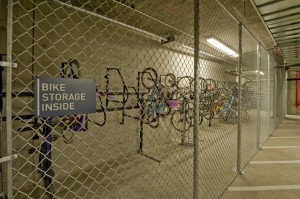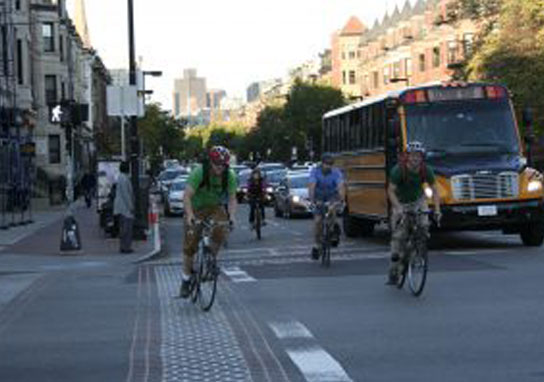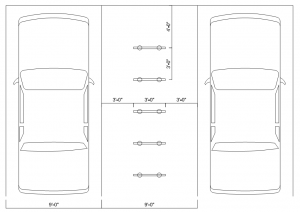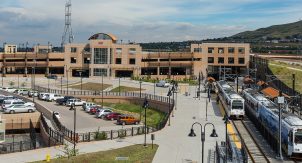Can the lack of a safe and secure bicycle parking facility be a leading factor in preventing people from cycling to work?
Bicycle commuting has gained much acclaim in recent years, especially within urban communities. Increasingly, commuters are frustrated with driving in traffic or untimely, costly and crowded public transit. In response, commuters are using bicycles as an alternative and efficient means of transportation. A 2011 study by the League of American Bicyclists indicates that bike riding has more than doubled between 2001 and 2009 (1.7 Billion to 4 Billion)
Many cities throughout the United States have implemented programs to promote and encourage reduction of passenger vehicle commuting and an increase in bicycle commuting. Strategies in cities such as San Francisco, New York, Chicago and Boston include; taking initiatives to develop bike lanes, bike sharing programs and education to increase road-sharing awareness and safety.
However, studies by the New York Department of City Planning indicate that “the lack of a safe and secure bicycle parking facility is a leading factor preventing people from cycling to work. In addition, a lack of bicycle storage facilities in residential buildings can make bicycle ownership impractical.” In the same manner that parking garages are provided to secure, store and weather-protect motor vehicles from the elements, bicycles are in need of similar amenities.
In response to these demands, property owners are recognizing and beginning to accommodate the need for bicycle access, storage and protection. As a result, Walker Parking Consultants, a contributor to building and urban development, is increasingly faced and challenged by the heightened need for both public and private bicycle storage within parking garage facilities. The storage requirement is no longer a matter of a bicycle rack in front of the building or a room in the basement. The requirements and expectations are calling for the storage of hundreds, and in some cases thousands of bikes in urban facilities. In regard to addressing the issues of space, safety, security and convenience, the need for storage has become less about accommodating the few bicycle commuters and more about the shared use of a parking facility.
The dominant option is to leave bicycles outside, locked to a rack, a pole or a tree. This option works in some locations and at certain times of day. For the majority of the time, this type of storage is sufficient for short-term bicycle parking. An unfortunate consequence is it may provoke theft and property damage due to vandalism and exposure to the elements.
In cities like Boston, progress has been made in promoting and implementing standards for bicycle storage. New developments are required to provide bicycle parking, either secured outdoor parking near destinations, within 50 feet from entrance, or bicycle racks that can be located within 750 feet of the site (per Boston Transportation Department). This encourages residents and tenants to use bicycles rather than automobiles because parking is much more convenient and cost effective in contrast with the high price of motor vehicle parking.
Such ordinances are useful in achieving a minimum standard; however, in many cases they do not require protected facilities. A solution to providing protected bicycle parking is; the utilization of existing parking structures for bicycle storage areas, as well as the incorporation of storage in the design of new parking structures. Advantages of using parking structures for bicycle storage include:
- They are convenient and easy to access directly from the street
- They are designed to be safe and secure for patrons, as well as the storage of vehicles
- They are modular in nature
- Areas within parking tiers may be easily adapted into bicycle storage without losing large amounts of vehicular parking
Bicycle rack standards used for municipal properties may similarly be utilized within parking structures.
In many cases, shared use bicycle storage areas are removed and readapted into parking spaces in the winter months, since bicycle riding is largely seasonal in colder climates. Riders are less likely to commute via bicycle, but are more likely to drive or take public transit in the winter. An option to accommodate this depression in required bicycle storage is to use removable rack systems within parking structures that are easily readapted to the demand of bicycle parking.
Examples of re-adaptable bicycle storage:
 The use of wall-mounted bicycle storage systems that would not need to be removed for a vehicle to use the parking space (without using a fenced in enclosure).
The use of wall-mounted bicycle storage systems that would not need to be removed for a vehicle to use the parking space (without using a fenced in enclosure).
For added safety and security, use of removable bike lockers that can be disassembled and stored when not in use.
In summary, as bicycle commuting continues to become a more prominent means of transportation, the demand for bicycle storage facilities will continue to increase. The use of parking structures as a dual-purpose facility is an option for safety, security and protection. The transition will indubitably require education and participation from parking garage owners and patrons, as well as new bicycle users. Although for many a major advantage of bicycle commuting is the low to no-cost commuting. Considering the high cost of building and maintaining parking, will it warrant bicycle parking payment implementation?
About the Author:
Sarah Morkos, Assoc. AIA, LEED AP is a Design Architect III in Walker’s Boston Offices. Sarah has been involved in the architectural design of parking structures, parking and signage consulting domestically and overseas.





